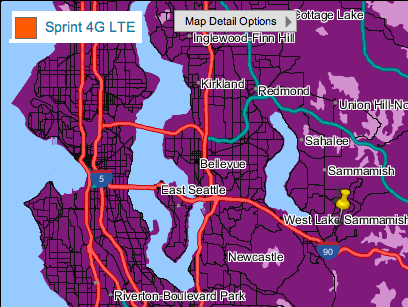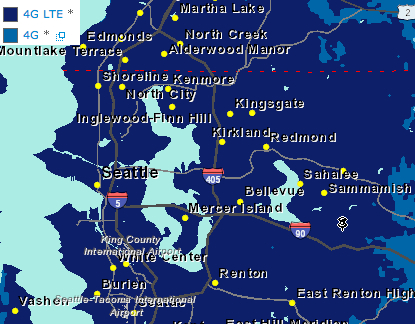If you compare the most current LTE coverage in the Seattle area (as of April 28th, 2013), you’ll see the following:
Sprint 4G LTE Coverage

So, the 4G LTE coverage for Sprint should be the orange colored regions on the map. Did you notice something? There is no orange colored regions! So, there is no LTE coverage in the Seattle area.
The map below shows the AT&T 4G LTE coverage in the same Seattle area:
AT&T 4G LTE Coverage

The dark blue regions have 4G LTE coverage, and as you can see that is almost the entire Seattle area! The light blue regions are 4G coverage, which is still pretty fast for data speeds. Quite a drastic comparison between Sprint and AT&T 4G LTE coverage in Seattle. So, does it make sense for me to keep paying for unlimited but very slow data speeds for the next year or more when I can have very fast data speeds (albeit 3 GB capped) for nearly the same monthly charges?
A note about data coverage for Sprint and AT&T:
With my HTC 4G EVO LTE Sprint phone, I could only get the very slow 1xRTT data connection, 3G, or 4G LTE connection. The “4G” data connection (called WiMAX) was not available to me since my Sprint phone didn’t have a radio that could connect with it. And rightly so, since WiMAX is now a defunct protocol in lieu of LTE. So the best I could do in the Seattle area was a 3G connection, with the 1xRTT as a fallback when the 3G wasn’t available.
With my AT&T, they have several levels of fallback for data connections. First is 4G LTE which is the fastest, and then if that wasn’t available it would fallback to 4G (which is also fast). 3G would be next, then there’s the slow 1xRTT equivalent. With AT&T’s 4G there’s actually two different levels of connections, so you have several different tiers you can fall back with and still have good speeds. With Sprint, it’s either 3G or the 1xRTT for the HTC EVO phone.
Now, maybe Sprint will have their LTE up and running in 2014-2015 and it could be great. But I would guess it might be until the end of 2015 before they work out all the kinks and have a good portion of Seattle adequately covered. Until then, I’ll stick with AT&T and enjoy the consistent faster speeds.



 Posted by zunetips
Posted by zunetips  I’ve got an HTC EVO 4G LTE Android smartphone, but Sprint hasn’t turned on LTE for the general Seattle, WA area yet (just some very small test areas). I was surprised to find the “4G” icon light up on my HTC phone while traveling to Orange County in Southern California last week. The LTE signal was strong and consistent at the Orange County Airport (SNA), and it was spotty in the Disney Grand Californian Hotel lobby. I used the Android app called, “SignalCheck Lite” which verified that I was connected to the LTE network and not EV-DO. Pretty cool, as the SpeedTest I ran showed approximately 7 Mbps download speed. Can’t wait until Sprint lights up my home town in the near future.
I’ve got an HTC EVO 4G LTE Android smartphone, but Sprint hasn’t turned on LTE for the general Seattle, WA area yet (just some very small test areas). I was surprised to find the “4G” icon light up on my HTC phone while traveling to Orange County in Southern California last week. The LTE signal was strong and consistent at the Orange County Airport (SNA), and it was spotty in the Disney Grand Californian Hotel lobby. I used the Android app called, “SignalCheck Lite” which verified that I was connected to the LTE network and not EV-DO. Pretty cool, as the SpeedTest I ran showed approximately 7 Mbps download speed. Can’t wait until Sprint lights up my home town in the near future. Sprint is releasing the HTC EVO LTE Smartphone tomorrow (Saturday, June 2nd), so I’ve decided that I will be upgrading to that phone. Since I’m only about 9 months into my 2 year contract with Sprint, I couldn’t take advantage of the “Upgrade” heavily subsided price. So to make my new purchase as affordable as possible, I did a “Upgrade Buyout” which means I pay a certain amount of money (based on the remaining number of days on my contract) to move my upgrade date forward to today. This fee is normally $5 less than the Early Termination Fee (which in my case is $150-$5=$145). So my upgrade cost would total to $145+$199=$344, which is much better than the $550 list price. To do this upgrade, I dialed *2 on my phone and selected the menu item for canceling my line. I then explained I wanted to do the early upgrade buyout and after the Sprint Rep made the change, it became active at 9 am the next morning.
Sprint is releasing the HTC EVO LTE Smartphone tomorrow (Saturday, June 2nd), so I’ve decided that I will be upgrading to that phone. Since I’m only about 9 months into my 2 year contract with Sprint, I couldn’t take advantage of the “Upgrade” heavily subsided price. So to make my new purchase as affordable as possible, I did a “Upgrade Buyout” which means I pay a certain amount of money (based on the remaining number of days on my contract) to move my upgrade date forward to today. This fee is normally $5 less than the Early Termination Fee (which in my case is $150-$5=$145). So my upgrade cost would total to $145+$199=$344, which is much better than the $550 list price. To do this upgrade, I dialed *2 on my phone and selected the menu item for canceling my line. I then explained I wanted to do the early upgrade buyout and after the Sprint Rep made the change, it became active at 9 am the next morning. I love my Nexus S 4G smartphone because of the bright screen, quick operation, and the fact I can install custom ROMs if desired. The one thing I really am disappointed with is the cellular radio performance. I routinely only get 1 or 2 bars with my Nexus S on the Sprint Network, while with my old Palm Pixi I almost always got a full set of bars. In fact, it seems that I often get zero bars and switch from 3G to 1x while driving around the Seattle area. What’s up with that?
I love my Nexus S 4G smartphone because of the bright screen, quick operation, and the fact I can install custom ROMs if desired. The one thing I really am disappointed with is the cellular radio performance. I routinely only get 1 or 2 bars with my Nexus S on the Sprint Network, while with my old Palm Pixi I almost always got a full set of bars. In fact, it seems that I often get zero bars and switch from 3G to 1x while driving around the Seattle area. What’s up with that? This
This Sprint will be selling the Palm Pixi Smartphone running WebOS (same operating system as the Palm Pre) tomorrow, and I’ve decided to get it. Although I’ve been developing applications for the Palm Pre for the last few months, I’ve held off getting an actual Palm Pre phone because I was waiting for Palm to firm up their Palm Catalog program. In addition, I wasn’t so crazy about slider phones, so I was waiting to see what the 2nd WebOS phone would be like, and non-slider candy-bar phone is what appeared in the Palm Pixi.
Sprint will be selling the Palm Pixi Smartphone running WebOS (same operating system as the Palm Pre) tomorrow, and I’ve decided to get it. Although I’ve been developing applications for the Palm Pre for the last few months, I’ve held off getting an actual Palm Pre phone because I was waiting for Palm to firm up their Palm Catalog program. In addition, I wasn’t so crazy about slider phones, so I was waiting to see what the 2nd WebOS phone would be like, and non-slider candy-bar phone is what appeared in the Palm Pixi.
You must be logged in to post a comment.